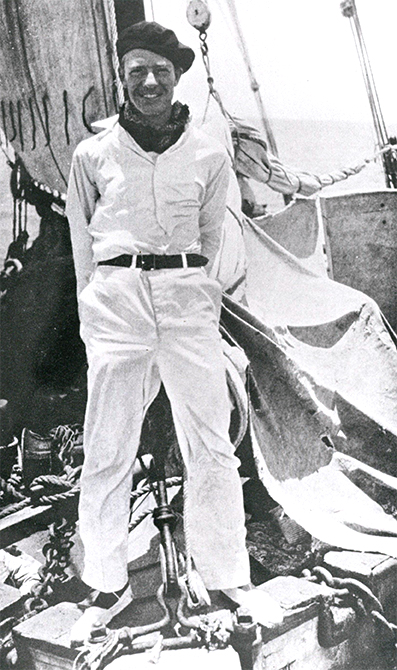
Richard Halliburton on one of his adventures. General Texas Collection Photographs–People–Richard Halliburton
“Armstrong’s Stars” is a collaboration between the Armstrong Browning Library and Baylor’s Texas Collection. Once a month we feature a story about a celebrity that Dr. A.J. Armstrong brought to Baylor. These stories highlight an interesting part of Baylor’s history and include collection materials housed in both the Armstrong Browning Library and The Texas Collection.
This month’s story was contributed by Amie Oliver, Librarian/Curator of Print Materials, The Texas Collection.
One of the most exciting personalities to ever visit Baylor is one who has seemingly been forgotten by many. Writer and adventurer Richard Halliburton came to Baylor twice at the invitation of Sigma Tau Delta. His first visit occurred on March 23, 1929, just after appearances in Austin and Dallas, where thousands were turned away. Crowds from as far away as Hillsboro, Mexia, Belton, and Temple were expected in Waco (“‘Playboy Adventurer’ to be Presented in Chapel Tonight at 8” 1).
Apparently Halliburton’s lecture did not disappoint. He began by stating, “I am the only lecturer who has ever come to you with no philosophy, with no message, with no uplift, and with no problem to solve.” He then regaled the audience with tales of adventure exploring three continents as he “would rise to romantic heights and would dramatically sway his body as he told of a tense moment in one of his thrilling adventures” (“Tales of Adventure Captivate Audience” 1). Halliburton entertained the audience for two and half hours. So moved by the performance, an article appearing on the Lariat editorial page nearly a week later declared:
“We were sorry that there were many in his audience who did not catch in a slight way the spirit of adventure and romance…. We were sorry that many went away still satisfied with their own little lives, content with the lethargy which had characterized their former days, and content to remain in Waco or in McLennan County the remainder of their brief span on this globe. They are the mediocre men and women who spend their time admiring the works of other men and pitying themselves for not being greater” (“Wanderlust” 2).
Halliburton’s appearance raised more than $100, which was earmarked for the purchase of a bookcase for the Browning Collection (“English Frat Plans Trip to Fort Worth” 1).

Student newspaper article promoting Halliburton’s first appearance at Baylor University. Baylor Lariat, February 15, 1929.
Seven years, three books, and one film later, Halliburton returned to Baylor for a lecture on March 19, 1936. Student tickets were reduced from 75 to 35 cents in an effort to entice many to attend the event at Waco Hall (“Halliburton to Speak Thursday in Waco Hall” 1). A McGregor high school student, Richard Phelan, longed to see his hero and hoped to interview him for his school paper (Phelan 64). Once at Baylor for the event, Phelan learned that a private post-lecture reception would limit opportunities to meet him. However, Mrs. Armstrong encouraged him to wait with other students seeking autographs backstage in the hopes that Halliburton would answer some questions (78).
When Halliburton took the stage, he noticed empty seats in the orchestra and invited students in the balcony to come down. Phelan noted that after Halliburton’s invitation, an older gentleman walked on stage and stepped into the wings. Just a few remarks into his lecture, Halliburton was called off stage. When he returned to the podium, he appeared shaken, but he continued his presentation (80).
After the event, Phelan headed backstage, where he got his autograph—and more. Mrs. Armstrong personally introduced Phelan to Halliburton and proposed an interview. Phelan and Halliburton dined at the Elite Café, where Halliburton told him that Dr. Armstrong was the gentleman who called him off stage to inform him that orchestra seats were sold at full price and students should not have been asked to move from the balcony. Halliburton was embarrassed by the faux pas. He was also disinvited from the reception in his honor, which is why Phelan was able to score the dinner and interview with his hero (103). Of course, most never knew about the exchange between Halliburton and Armstrong. Luther Truett of the Lariat published an article praising the lecture and Halliburton, the man who “held an audience spellbound for two hours without a blank moment.” Truett did note Halliburton’s gracious invitation for students to move from the balcony to the “best seats in the house” (Truett 3).
Halliburton was declared legally dead in late 1939 after the boat he was traveling on from Hong Kong to San Francisco sank during a typhoon. The Lariat published an article about Halliburton’s death, praising the “unique and unusual man” for accomplishing amazing feats, exploring foreign lands, for living a life that others envied, and who “died doing exactly what he wanted to do” (“Halliburton: American Ulysses” 2).
Works Cited
“English Frat Plans Trip to Fort Worth.” Lariat 29 March 1929: 1. Web. 26 Feb. 2015.
“Halliburton: American Ulysses.” Lariat 13 Oct. 1939: 2. Web. 26 Feb. 2015.
“Halliburton to Speak Thursday in Waco Hall.” Lariat 17 March 1936: 1. Web. 26 Feb. 2015.
Phelan, R.C. “Halliburton’s Banana Peel.” Vogue Feb. 1960: 64-105. Print. Richard C. Phelan papers, The Texas Collection, Baylor University.
“‘Playboy Adventurer’ to be Presented in Chapel Tonight at 8.” Lariat 23 March 1929: 1. Web. 26 Feb. 2015.
“Tales of Adventure Captivate Audience.” Lariat 26 March 1929: 1. Web. 26 Feb. 2015.
Truett, Luther. “Author Captures Audience Praise.” Lariat 20 March 1936: 3. Web. 26 Feb. 2015.
“Wanderlust.” Lariat 27 March 1929: 2. Web. 26 Feb. 2015.
